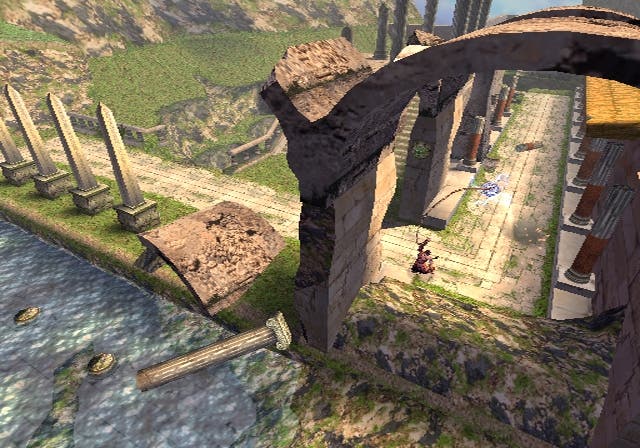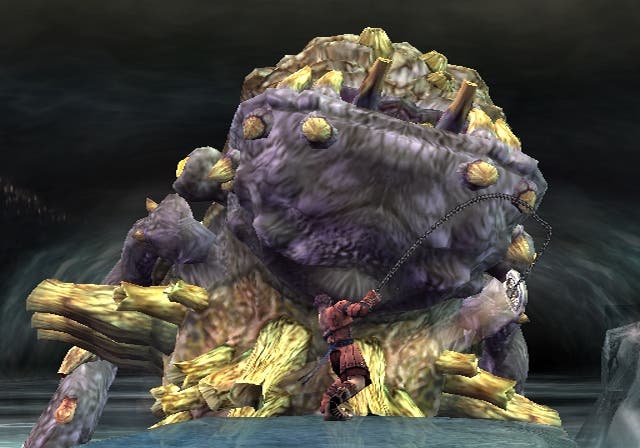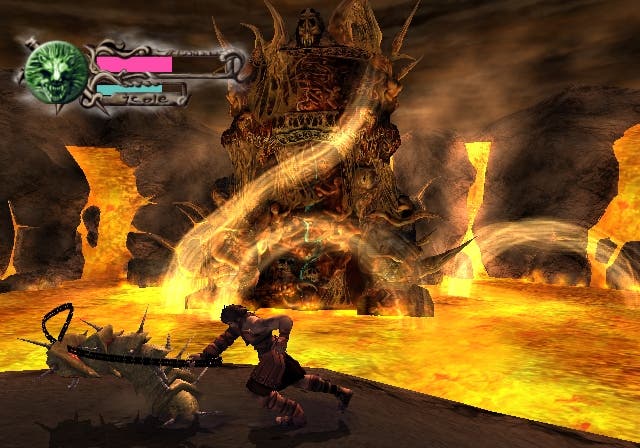Rygar: The Legendary Adventure
Martin doesn't get to go to E3, but he does get to go on a Legendary Adventure. Snigger.
Having never played Tecmo's original and apparently well-loved Rygar, it's safe to say I was going into this one blind. Yes, I've seen all the shots, and even the little movie of Rygar swinging his yoyo about, breaking bits of rock, but honestly... I wasn't anticipating much, despite the game's esteemed dynasty. [We were - Eds] Piss off guys!
The Legendary Pilfering

Rygar is a gladiator armed with nothing but a yoyo and some dialogue well and truly saturated in cheese. There is a startlingly extensive and rather complicated plot, which has something to do with Rome, Egypt, Greece, a number of characters pilfered from various myths and legends, the captured Princess Harmonia, and the evil Titans, once banished to the underworld, roaming the land and generally causing a bit of a fracas.
We couldn't really decipher much more than that from the introductory CGI, or subsequent cut-scenes for that matter, but to be honest all we cared about and needed to know was that some beasties needed to be shown the door, and Rygar was the man for the job (one of those darned prophecies roped him into it). Titbits of plot after the beginning of the game are gleaned from fragments of slate inscribed with the story, available for perusal at your leisure once you've found them, but failing to unravel the hodgepodge of a plot won't ruin your enjoyment of this adventure one bit.
To aid Rygar in his quest to save the princess and rid the world of Cronus - the evil god behind his mess - our hero is given a fine Weapon of Choice: the Diskarmor, a spinning shield-like object on the end of a long chain. Rygar eventually finds something like 30 different ways to use his Diskarmor via a system of button combinations and stick movements. To start with he can use it as an actual shield, and get it to whip in front of him, swing it in both directions and flick enemies into the air or each other. But as the game drives on Rygar earns new skills, and by the time you're halfway through the game, he's taking on dozens of enemies at a time, spinning around, and flinging, shoving and beheading enemies left, right and centre in some impressive death dances that easily rival Dante's moves in Devil May Cry (the similarities with which don't end there).
Rygar eventually ends up with three Diskarmors; Hades, Heavenly and Sea, each of which have their own distinct uses. Hades is useful for general purpose fighting, a sort of all-round tool of destruction, while Heavenly has a longer range and can be swung with the analogue stick, useful for when you're surrounded by advancing groups of adversaries, and the Sea Diskarmor is a powerful close-range weapon, superb for banishing clusters of enemy into mythology. Each Diskarmor can be further upgraded and slightly customised with magic stones, which imbue them with abilities like an automatic defensive stance. What appears at first to be a fairly original but effectively simple weapon turns out to have a great deal of customisable qualities and hidden depth to it. And depth is something which runs throughout the entire game.
Devil May Cry? Devil May Care

Rygar is slow to start as the adventure begins within a ruined Greek temple, and it reminded us of Devil May Cry right from the outset. It's a game of dismembering small bands of identical, oversized, respawning caterpillar beasts with a few swings of the yoyo; finding a door sealed with magic; locating and rotating a statue required to unlock that door; and repeating ad nauseum. The most jarring aspect of the game when you first begin to play, however, is the semi-fixed camera which is grudgingly functional but mostly damned irritating, often refusing to let you see where you're going properly. It takes perhaps fifteen minutes' play at the most to reach and beat your first boss, a gargantuan possessed set of statues depicting a god, a warrior and horse.
Simple enough to defeat, the first world and boss of Rygar immediately set us up expecting a rather disappointing run for the rest of the game. The second world, however, is where it truly comes into its own. The graphical aplomb with which Tecmo has constructed the lush, overgrown and crumbling environment that Rygar must explore is instantly arresting. Ruined buildings and statues litter your path, and what's more, much of it will crumble away as Rygar gets involved in battle and his Diskarmor ricochets from the columns and scenery, taking them down with his enemies. Most of the scenery is destructible, and the game rewards you for exercising your demolishing tendencies, offering the odd power-up here and there for a column reduced to rubble. The power-ups usually take the form of build-up points with which you can level up your Diskarmors.
Once the adventuring starts proper, slipping into the role of Rygar becomes more compelling, and exploring the lovingly detailed and dynamic, devolving environments becomes a pleasure despite the rudimentary 'this statue unlocks this door' progression. The only major drawback is that damned camera - we were stuck for a good couple of hours traipsing back and forth across one level attempting to find a door, which turned out to be hidden beneath a ledge that was directly under the camera. Totally out of view. If Tecmo insists on remanding control of the camera from the player, the least they could do is throw in the ability to stand still and look around in the first person.
Pillar of Smash

Puzzle elements, for their part, aren't in particular abundance, and when they are the game usually relies on you to keep doing what you do - knocking over pillars with your Diskarmor to traverse gaps, for example, isn't immediately obvious because they generally crumble into heaps of dust, but it doesn't hurt to try these things. So if in doubt, smash everything [sage-like counsel there, boyo -Ed].
But despite the straightforwardness of the game, Tecmo cleverly drip-feeds the player with a new skill for Rygar here, and an intriguing and seemingly unreachable power-up there, and each level is substantially different in style to keep you wondering what's coming up next. Often the magnificent ruined architecture gives way to ethereal chambers of light, with Rygar fighting his way through dusty halls with only a few choice beams of sunlight picking through the gloom, and those in turn give way to water and lava-packed networks of underground caves and so on. And what about those extra abilities we were talking about? Ah yes, just when you think you're running out of options, Rygar goes and learns how to use his Diskarmor to grapple his way across chasms, or lift himself out of pits, lending the game new angles and opening up possibilities in earlier sections.
Character design is less interesting and develops less impressively than the environments and game itself, and it becomes boring when you start to get over-familiar with most of your basic, nondescript adversaries. Squirmy caterpillar things we've already mentioned, and they join a cast of jumpy fast things, flying swoopy things, floaty teleporting things, the occasional mallet-wielding Cyclops... you get the idea [that we didn't get a manual -Ed]. But real adversarial creativity comes in the form of enormous and beautifully constructed boss creatures, although these are sadly defeated with the usual attack-run-defend-attack combo - it's a shame that with such an unusual and interesting weapon, Tecmo couldn't have implemented more unusual and interesting ways to take care of the game's main challenges.
Devilishly good

It's fair to say that Rygar: The Legendary Adventure caught me unawares. Despite appearing to lean on many of its generic siblings for influence, and in particular Devil May Cry in the combat and progression stakes, it's an adventure that has a feel of its own. The story and acting is guff - and easily ignored - but the sense of being involved in some epic fantasy movie is quite tangible. The visuals and - before we forget - beautiful soundtrack lend the pacing and impressive development of the Rygar character qualities that urge you to continue.
Had it not been for the frequently infuriating camera, and had it not taken so long to get going and proven to be fairly short once it got good (weighing in at something like 10-15 hours play on the regular setting), Rygar could have been significantly more impressive than it already is. But for the most part it's damned good - Tecmo delivers another PS2 treat.








